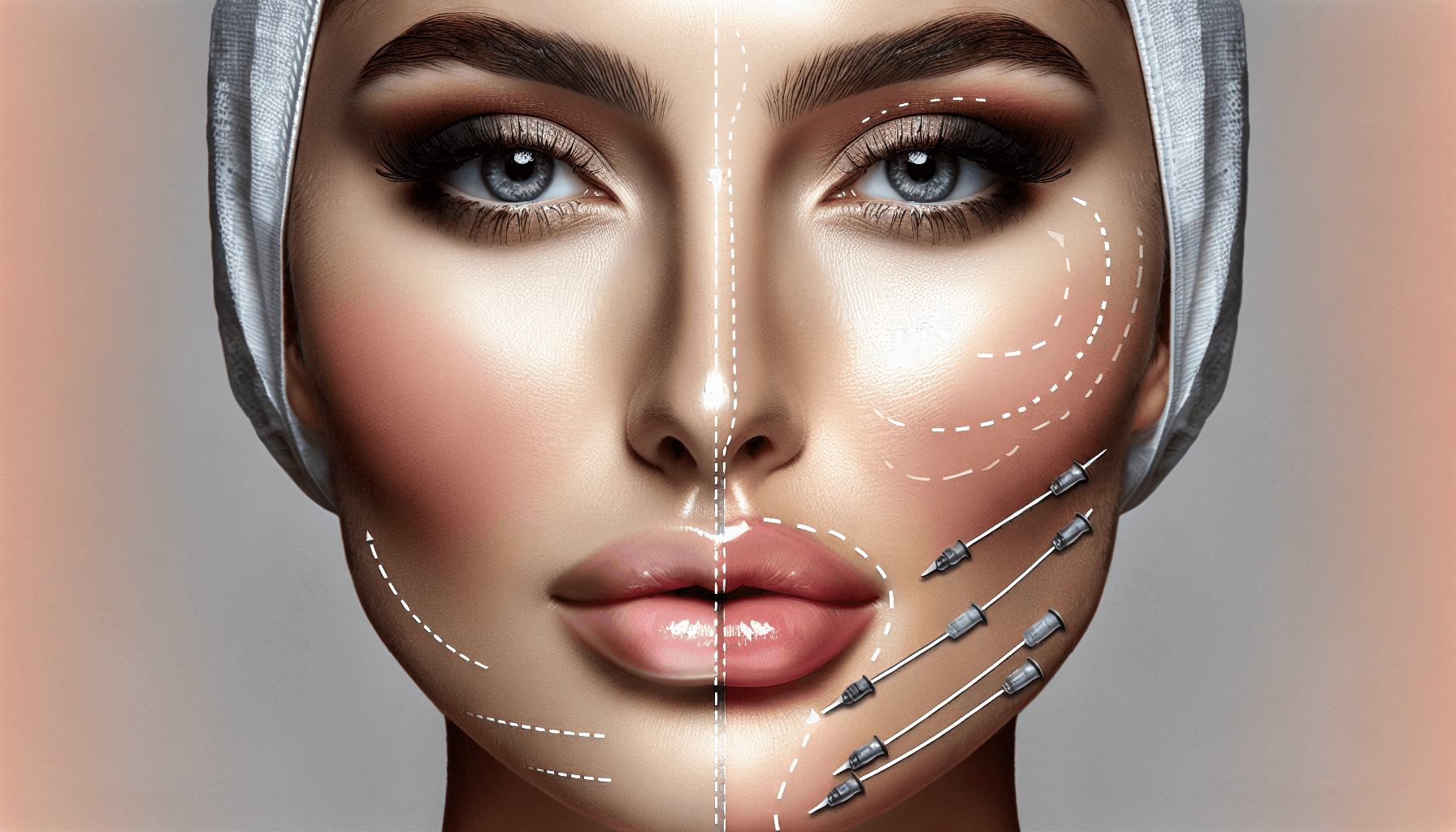Cheek augmentation is a cosmetic procedure tailored for individuals seeking to enhance the appearance of their cheeks, catering to those with flat, thin, or saggy facial contours, or simply those dissatisfied by their cheek’s appearance. It’s essential for candidates to consult with a plastic surgeon to determine the optimal cheek enhancement method, whether through cheek fillers, cheek bone surgery, or other facial implants, based on their unique facial structure, health status, and aesthetic goals.
This process, while appearing straightforward, involves careful consideration of various factors including the longevity of cheek fillers, the intricacies of facial plastic surgery, and the detailed comparison of cheek filler before and after results. Prospective patients must discuss potential risks with a qualified plastic surgeon and maintain realistic expectations, especially non-smokers in good physical health with a stable weight, to ensure the success of their cheek bone implants or fillers.
Understanding Cheekbone Aesthetics
Cheekbone aesthetics play a crucial role in facial harmony and symmetry, influencing perceptions of beauty and youth. High cheekbones, sitting closer to the eyes, are often associated with higher levels of estrogen and perceived trustworthiness. They affect how light interacts with the face, creating gentle shadows and highlights that enhance facial features. Various procedures aim to accentuate these cheekbone features, including surgical options like cheek implants and nonsurgical methods such as dermal fillers and makeup techniques.
Surgical and Nonsurgical Enhancements
- Surgical Options: Cheek implants, also known as malar implants, are permanent solutions made from solid, pliable materials like silicone, designed to restore volume and lift the midface. These implants can be customized in thickness, size, and shape to suit individual facial structures, offering a more sculpted appearance.
- Nonsurgical Options: Injectable fillers like JUVÉDERM® VOLUMA and Restylane Lyft provide a temporary solution for enhancing cheek volume. These fillers, mainly composed of substances like hyaluronic acid, are absorbed over time and require periodic reapplication to maintain their effect. They are popular due to their minimal downtime and immediate results.
Lifestyle Influences on Cheekbone Appearance
Maintaining high cheekbones isn’t solely dependent on medical procedures. Lifestyle choices play a significant role. A healthy diet, adequate hydration, sufficient sleep, regular exercise, and minimizing harmful habits like smoking can all contribute to better skin health and more pronounced cheek contours. Makeup techniques using matte bronzers, contour powders, and highlighters can also enhance the natural structure of the cheekbones, providing depth and radiance without the need for surgical intervention.
Pros and Cons of Cheek Fillers
Benefits of Cheek Fillers
- Immediate Enhancement: Cheek fillers provide immediate or near-immediate results, adding volume and reducing signs of aging almost instantly.
- Non-Surgical Convenience: Unlike surgical alternatives, cheek fillers do not require general anesthesia and the procedure takes less than an hour, making it a convenient option for many.
- Temporary Adjustments: The effects of cheek fillers are not permanent, lasting anywhere from 6 months to 2 years, allowing adjustments as natural aging continues.
- Collagen Stimulation: Some fillers stimulate collagen production, which helps maintain skin structure and firmness over time.
- Versatility: Fillers can be used not only to enhance cheek volume but also to smooth wrinkles, fill under-eye hollows, and even treat medical conditions like chronic migraines or excessive sweating.
Risks of Cheek Fillers
- Potential for Side Effects: Common side effects include bruising, swelling, redness, and tenderness at the injection site. More severe reactions, though rare, can include allergic reactions, infections, and even vascular complications which could lead to tissue death.
- Cost Considerations: While less expensive than surgery, the cost of fillers can add up over time, especially since they require repeated sessions to maintain results. Prices vary widely depending on the type of filler and the volume used.
- Impermanence: The temporary nature of fillers means repeated treatments are necessary, which can be a drawback for those seeking a more permanent solution.
- Skill-Dependent Results: The success of filler treatments heavily depends on the skill and experience of the provider, with poor technique possibly leading to asymmetry, lumps, or unnatural appearance.
These factors highlight the importance of consulting with a skilled dermatologist or plastic surgeon to discuss the best options based on individual facial structure and aesthetic goals.
Pros and Cons of Cheek Implants
Benefits of Cheek Implants
- Long-Term Solution: Cheek implants are a permanent method to enhance facial contours, providing a long-lasting solution without the need for frequent touch-ups.
- Natural Appearance: Once healed, cheek implants blend seamlessly with natural facial structures. They are designed to look natural and remain stable even as you age, ensuring the cosmetic benefits endure for decades.
- One-Time Procedure: Unlike fillers that require repeated sessions, cheek implants involve a single surgical procedure. This can be more cost-effective over the long term despite the higher initial cost.
- No Visible Scarring: The surgery typically involves incisions inside the mouth, which means no external scars are visible, preserving the aesthetics of the facial appearance.
Risks of Cheek Implants
- Surgical Risks: As with any surgery, cheek implants carry risks such as infection, nerve injury, or complications from anesthesia. The risk of infection might necessitate a second procedure to correct or remove the implant.
- Recovery Time: Patients need to account for downtime following the surgery, which includes dealing with swelling and potential bruising. Full recovery and the final results might take several weeks to become apparent.
- Permanent yet Reversible: While cheek implants are designed to be permanent, they can be removed if dissatisfaction occurs. However, removing implants, especially those that integrate with bone like Medpor, can be challenging and might require additional surgery.
- Cost: Initial costs for cheek implants are higher than non-surgical options due to the surgical procedure involved. This might be a significant consideration for those with limited budgets.
Making the Right Choice for You
When considering cheek enhancement, individuals are often faced with the choice between cheek implants and fillers. Both methods are safe and effectively enhance facial aesthetics by making the cheeks appear fuller, plumper, and more youthful. Here are the key factors to consider when making your decision:
- Longevity and Flexibility: Cheek implants offer a permanent solution, ideal for those seeking long-lasting results without the need for frequent touch-ups. In contrast, cheek fillers are temporary, generally lasting 9 to 18 months, but they allow for adjustments over time as your facial structure changes with age.
- Invasiveness and Recovery: Implants are more invasive, requiring surgery and a recovery period, which might include downtime from daily activities. This option might appeal to those looking for a one-time procedure. On the other hand, fillers are less invasive, involve minimal recovery time, and can be administered during a short clinic visit, making them suitable for individuals seeking less commitment and quicker results.
- Consultation and Personalization: It is crucial to consult with a board-certified facial plastic surgeon who can assess your specific facial features, medical history, and aesthetic goals. This personalized approach helps in determining which procedure—implants or fillers—will best meet your expectations and lifestyle needs.
Choosing the right cheek enhancement option involves weighing these factors against your personal preferences and long-term aesthetic goals.
FAQs
1. Which is preferable for cheek enhancement: implants or fillers?
Cheek implants offer a permanent enhancement, whereas fillers provide temporary results lasting between 9 to 18 months, depending on the filler type and quantity used. Starting with fillers might be beneficial as they allow you to preview the potential outcome of a permanent implant and can be removed if desired.
2. What are the potential drawbacks of getting cheek implants?
Cheek implants come with certain risks and complications that your plastic surgeon will discuss with you. These may include bleeding, infection, and numbness.
3. Are cheekbone implants a worthwhile investment?
Cheek implants can effectively and permanently alter your facial appearance, whether to combat aging effects or achieve a desired look. This procedure is generally considered safe, involves a quick operation, and requires a relatively short recovery period.
4. What are the alternatives to cheek implants?
Alternatives to cheek implants include dermal fillers, which can last from 6 to 24 months depending on the type used. Another option is fat grafting, which involves transferring fat from one part of the body to the face, providing a more voluminous appearance across the entire face.
References
[1] – https://www.plasticsurgery.org/cosmetic-procedures/cheek-augmentation
[2] – https://www.plasticsurgery.org/cosmetic-procedures/cheek-augmentation/candidates
[3] – https://www.ejyfacialplastics.com/cheek-enhancement/
[4] – https://carolinafacialplasticsurgery.com/cheek-fillers-101-everything-you-need-to-know/
[5] – https://www.realself.com/surgical/cheek-implants
[6] – https://www.torontofacialplastic.com/cheek-implants-types-surgery-recovery-benefits/
[7] – https://aedit.com/procedure/cheek-augmentation-cheek-implants
[8] – https://www.txfaces.com/procedures/plastic-surgery/cheek-augmentation/
[9] – https://my.clevelandclinic.org/health/treatments/24260-cheek-filler
[10] – https://isfecalaesthetics.com/en/cheekbone-aesthetics/
[11] – https://www.seewhatsbeyond.com/cheekbone-contouring/
[12] – https://www.drkristyhamilton.com/non-surgical/cheekbone-contouring/
[13] – https://aedit.com/aedition/cosmetic-procedures-to-define-cheekbones
[14] – https://www.referenceaesthetic.com/elevate-your-look-all-about-high-cheek-bones/
[15] – https://healthcare.utah.edu/plastic-surgery/facial/facial-implants-vs-fillers
[16] – https://www.drclevens.com/blog/cheek-implants-vs-fillers-how-to-decide-which-is-right-for-you/
[17] – https://buglinoplasticsurgery.com/blog/pros-cons-a-beginners-guide-to-fillers-injectables/
[18] – https://my.clevelandclinic.org/health/procedures/cheek-implants
[19] – https://www.hovecenter.com/blog/2019/11/17/cheek-implants-vs-juvederm-injections-202613
[20] – https://doctorlanna.com/cheek-fillers-vs-cheek-implants/
[21] – https://carolinafacialplasticsurgery.com/implants-vs-fillers-whats-the-best-option-for-your-face/










